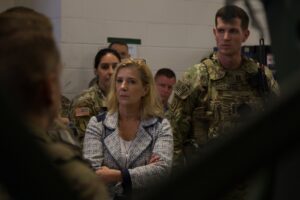Army Secretary Christine Wormuth on Wednesday laid out a detailed vision for the service’s role in potential future conflicts with China, noting the Army may function “as the linchpin service for the joint force” in the Indo-Pacific theater.
Wormuth said she believes much of the discussion on the Army’s role in the Indo-Pacific “has been framed around battles over the defense budget or interservice rivalries,” rather than the key components the service would bring to a potential fight with China.

“The reality is that competing militarily and strengthening deterrence in the Indo-Pacific is a joint undertaking. And, certainly, any potential military conflict with China would require the entire joint force, not just air and maritime forces,” Wormuth said during a Center for Strategic and International Studies discussion.
More specifically, Wormuth said the Army’s role in a fight with China would be focused on five core tasks, to include providing integrated air and missile defense, sustaining the joint force with logistics and communications, running command and control at multiple operational levels, bringing ground-based long range fires and utilizing its maneuver forces.
On her comment that the Army would be “the linchpin service,” Wormuth said that means the “Army will establish, build up, secure and protect staging areas and joint operating bases for air and naval forces in theater,” to include providing integrated air and missile defense for fixed sites and mobile elements.
Sustaining the joint force would include the Army providing the secure communication network backbone, generating intratheater distribution networks for logistics and resupply and maintaining munitions stockpiles and forward arming and refueling points, according to Wormuth.
For ground-based long-range fires, Wormuth said future systems such as the Long Range Hypersonic Weapon, Precision Strike Missile and Mid-Range Missile will be key components to the joint force’s strike capabilities.
“We will be able to interdict fires across sea lines of communication, suppress enemy air defenses and provide counter-fires against mobile targets,” Wormuth said.
Army leadership has faced questions on the potential redundant role for long-range strike capability across the services, with Army Chief Gen. James McConville saying recently the service’s pursuit of such weapons is to present multiple dilemmas for adversaries while also providing the ability to penetrate enemy environments and open up operational pathways for the Air Force, Navy and Marine Corps (Defense Daily, March 30).
The Pentagon’s latest annual report on China’s military activities detailed Beijing’s rapid modernization push, including plans to have an arsenal of at least 1,000 nuclear warheads by 2030 (Defense Daily, Nov. 3).
“We shouldn’t be seeking, in my view, a second Cold War or asking our allies and partners to choose between the United States and China. But we also should not underestimate China and the challenges it poses for the United States,” Wormuth said on Wednesday. “As I said at my confirmation hearing, we are at a strategic crossroads. We are in a competition with China that has far-reaching consequences. And while I firmly believe the most important dimensions of this competition are not the military ones, the military piece is a foundational element that we have to get right.”